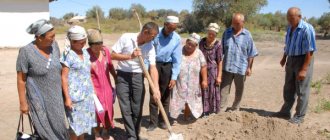Pravozhil.com > Real estate registration > Reserve lands are territories not encumbered with economic purposes
Reserve lands - what is it, let's understand the terminology. The chapters of the Land Code reflect information on existing categories of land according to the target profile.
The legal aspects of the main six appointments are clear and understandable:
- land for farming
- territories of cities and towns
- areas for the conservation of especially valuable natural areas
- forest lands
- lands of reservoirs
Reserve lands are a reserve category
What are reserve lands? Reserve lands are the seventh special category. From a legal point of view, the essence of land in this direction is poorly and vaguely described; their purpose, unlike other categories, is not indicated.
The reserve lands do not have a sufficiently clear description. The scope of their use does not have strict restrictions.
Lands are allocated according to the following formal characteristics:
- belonging to state funds or local governments;
- lack of owners of land plots;
- a ban on the use of the territory until the category is changed or transferred to someone else's jurisdiction.
Thus, in fact, the purpose of reserve lands is a soil reservation, not burdened with economic exploitation for human needs.
In the unified register of territories of the Russian Federation, empty spaces make up a third of the area or 6.4% of the country’s total fund.
Reserve lands are often unused, which means uninhabited. These include lands of undeveloped territories. For example, regions in the Far East, the Far North and Siberia, Altai Territory.
In the Central part of the Russian Federation, reserve lands occupy an insignificant place among other categories, although they are present in all subjects of the Federation.
Despite the “no man's land” of the sites, certain geodetic, survey, cadastral, and prospecting works can be carried out in agreement with the authorities.
Land reserve is a territory awaiting the needs of society in free development zones. The boundaries of reserve lands are flexible and change depending on the transfer of plots to other categories as they are in demand, developed and intended purpose.
It is impossible to occupy seemingly “free” lands on your own. Casual users and local residents often arbitrarily develop the territory.
If there is no major construction on the site, local authorities sometimes put up with vegetable gardens and plantings. They turn a blind eye to the use of reserve lands for agricultural purposes.
Reserve lands include lands that are in state or municipal ownership and are not provided to citizens or legal entities, with the exception of lands of the land redistribution fund. The use of reserve lands is permitted after their transfer to another category. Reserve lands include agricultural lands (arable land, fallow land, perennial plantings, forage lands), forests, lands under trees and shrubs, lands under water bodies, lands under swamps, building lands, lands under roads, disturbed lands, and other lands. In terms of area, these lands are a fairly common category. Reserve lands are often called undeveloped lands, as well as lands that became state and municipal property when the rights of citizens and legal entities to land were terminated. Such lands can be used for geodetic, geological surveying, prospecting, cadastral, land management and some other studies and surveys. Also, reserve lands can be used for the needs of transhumance livestock farming (for example, black lands, which should be understood as lands that are not covered with stable snow cover and are convenient for grazing livestock in winter). Classifying lands as reserve lands does not exclude their use, but this use will be specific. Reserve lands are used only if they are not provided to citizens and legal entities. Citizens and legal entities may have rights to land plots located on reserve lands only after the transfer of these lands to another category. Land plots as part of reserve lands can be classified as the property of the Russian Federation depending on certain conditions: - location on the land plots of real estate that is under federal ownership; — location on land plots of privatized real estate that was owned by the Russian Federation before its privatization. The basis for including land plots in the list of land plots for which the constituent entities of the Russian Federation acquire ownership rights is their inclusion in the reserve lands within the boundaries of municipalities if: on these lands there is real estate owned by the constituent entities of the Russian Federation; on these lands there is located privatized real estate, which before its privatization was owned by the constituent entities of the Russian Federation. The remaining land plots are classified as municipal property if they do not contain state-owned real estate or privatized real estate that was state-owned before its privatization (Federal Law of July 17, 2001 No. 101-FZ “On the delimitation of state land ownership"). It is also prohibited to use reserve lands until they are transferred to another category of land. However, the Land Code of the Russian Federation requires the use of reserve lands in accordance with their intended purpose. Citizens have the right to freely, without any permits, be on land plots that are not closed to public access, which have state and municipal ownership, and to use natural objects on these plots. To use land for the purposes of cattle herding, hunting and some other needs, the provision of land plots to specific citizens and legal entities is not required. Therefore, reserve lands can be used for these purposes without converting them to lands of other categories.
Dynamics of the territory
There are factors that contribute to changes in the area of reserve lands, both up and down
Reserves are continuously replenished or reduced depending on legislative decisions.
Reserve territories are increasing due to:
- return at the end of the period of use;
- voluntary refusal to develop the territory; avoiding the need to use sites;
- seizure for violation of the law;
- lands taken out of economic circulation, etc.
The decrease in the land reserve fund occurs as a result of decisions made about:
- creation of trust funds;
- providing plots to Cossack societies;
- resettlement of refugees and accommodation of internally displaced persons;
- about housing construction;
- farm organizations;
- formation of cooperatives, etc.
Does not apply to stocks
Plots abandoned by owners are not included in the described territories. Despite the homeless nature of the territories, the rights of the owners to them are preserved until changes are registered in the land cadastre documentation.
Only an official refusal can become the basis for changing the category of land allotment.
The conservation of these places is also not a basis for classifying them as reserve lands. Landowners temporarily exclude soil from economic use due to contamination with toxic industrial waste and land degradation.
Not all abandoned land plots are included in the described areas.
The identification of the redistribution fund with the places described is also erroneous. The Land Code specifies a list of grounds for creating a fund only from agricultural areas.
Legal regulation and rules for the use of redistribution lands are related to the goals of protecting and studying natural resources.
Replacing categories
The replacement rules are regulated by the Federal Law and carried out by the authorities:
- Government of the Russian Federation - for plots that are federal property;
- executive power on the territory of constituent entities of the Russian Federation - for agricultural lands owned by business entities or privately owned;
- local government - for lands that are municipal property (excluding agricultural land) and private holdings for various purposes.
Replacing the purpose of land in residential areas and, conversely, transferring any plots to the land fund for settlement and subsequent development is regulated through the placement of the boundaries of residential areas within the framework of the Land Code and legislation in the field of urban planning.
Replacement of land categories may occur under the influence of certain economic or demographic factors.
Legal status of reserve lands
In the Land Code of the Russian Federation there is a term for what is reserve land. Paragraph 1 of Article 103 provides a description of this legal concept. In simple terms, these are areas owned by the state, without legal owners and not intended for exploitation. They are reserve territories.
According to the legal regime, such areas cannot be used for construction, industry, agricultural or rural work. At the same time, geodetic, cadastral, land management and other work is permitted in such a space.
Plots that remain ownerless can be transformed into a group of reserve territories if the fact of their ownerlessness is reflected in the cadastral passport. In this case, they are transferred to the municipality and can be used at its discretion.
Voluntary renunciation of the right of ownership, use and disposal of plots by individuals or legal entities is allowed. Such a decision does not depend on the reasons that prompted the refusal. To do this, you must submit an application to the authorized agency. Ownership rights cease from the moment of state registration. After this, the responsibility for paying the relevant taxes falls on the municipality.
We suggest you read: If you don’t register your dacha house as your property if you own the land
Areas exposed to chemical or radioactive effects are also converted to reserve class. They are being relegated to conservation status. These plots may remain with the previous owner or become the property of the state. At the same time, land management regulations are developed, which indicate the conservation period, restoration procedures, assign a priority and calculate the cost.
Responsibility for cleaning and improving such areas lies with municipal authorities. They also initiate the transfer of plots to a different variety. Local governments have the right to register the property in the cadastral register and subsequently make it available to people for farming or for other purposes through an auction or competition.
Reserve lands are owned by the state or local authorities, which is one of the main characteristics of this type of territory. This does not mean that they are ownerless and forgotten: such areas are specially registered. The cadastral documentation contains all economic and legal information, and the law protects them from any actions that do not have the consent of the authorities.
The use of reserve lands is permitted after transfer to another category and determination of their intended purpose. This ensures their safety, because there are different requirements for the operation of territories and methods of protecting areas used in certain types of activities from damage. For example, the use of industrial facilities for the construction requires some measures to protect land, and the implementation of agricultural activities requires others.
Unowned territories, information about which is not contained in the state real estate cadastre, cannot become reserve lands. Only after the absence of the owner is reflected in the relevant decisions of local authorities, and the lands are handed over to the municipality, can they be classified into different categories.
Procedural features of replacing the category of reserve lands
The procedure for changing the category of reserve lands must be preceded by a state environmental assessment of the territory
The beginning of preparing a package of documents to change the category of a plot of land is to draw up a petition to government agencies or municipal authorities.
The applicant must provide information:
- about the cadastral number of the land plot;
- about categories of land (real and the one to which the transfer is being made);
- about the reasons for changing the category;
- from the Unified State Register about the non-ownership of the site by anyone;
- from the State Cadastre on the inclusion of a site in the category of reserve lands;
- on conducting a state environmental assessment.
A refusal to apply for a change in land category can be obtained if the content of the application or attached documents contradict the norms of the law. The applicant will receive a refusal certificate, which can be appealed in court.
In case of a positive decision, the act records the decision to assign the requested category of land.
The document reflects:
- reasons for changing the category;
- dimensions and boundaries of the site;
- cadastral number;
- indications of the old and new categories.
The category of land in reserve is subject to replacement upon application through lengthy and thorough procedures. The help of specialists significantly speeds up the process and makes it possible to turn abandoned land into a useful area for everyone.
In what cases is the use of reserve lands allowed?
103 of the Land Code of the Russian Federation). The composition of reserve lands may also include agricultural land plots for their conservation if they have been subjected to radioactive and chemical contamination and they do not provide production of products that meet the requirements established by law. At the same time, a distinction should be made between reserve lands and conserved lands. The transfer of lands that have been subjected to radioactive and chemical contamination and on which the production of products that meet the requirements is not ensured, into reserve lands for their conservation is only one of the ways to limit (exclude) their agricultural use (Article 14 of the Land Code of the Russian Federation). In general, the legal regime of reserve lands and conserved lands is different. Reserve lands do not include lands of the redistribution fund. According to modern legislation, a redistribution fund is created as part of agricultural land and is intended for the redistribution of land for agricultural production, the creation and expansion of peasant (farm) farms, gardening, livestock farming, gardening, haymaking, grazing (Article 80 of the Land Code of the Russian Federation). Reserve lands are subject to state registration along with lands of other categories. Reserve lands are either state or municipal property. The use of reserve lands is permitted only after their transfer to another category. Such a transfer is allowed after the formation of a land plot, in respect of which an act is adopted on the transfer of the land plot from reserve land to another category of land in accordance with the requirements of the Federal Law of December 21, 2004 N2 172-FZ “On the transfer of lands or land plots from one category to another."
Date added: 2015-02-04; ; Does the published material violate copyright? | Personal data protection |
Didn't find what you were looking for? Use the search:
What categories are possible for reserve lands?
Legislation allows the transfer of reserve lands to the following target categories:
- for development and placement of populated areas;
- for the construction of industrial facilities, production development;
- for the purpose of preserving valuable natural areas, for example, nature reserves;
- for the purpose of conducting agricultural work, including the necessary communications, plantings, facilities for processing products, roads;
- for the conservation of forest and water resources.
Russia has large reserves of land that have yet to be used in economic life and the lives of new generations have to be built on them.
For more details about lands for various purposes and their use, see the video:






